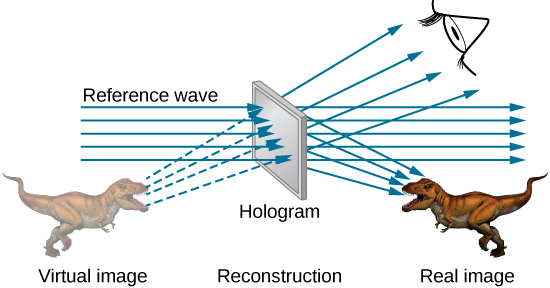| << Chapter < Page | Chapter >> Page > |

The hologram illustrated in [link] is a transmission hologram. Holograms that are viewed with reflected light, such as the white light holograms on credit cards, are reflection holograms and are more common. White light holograms often appear a little blurry with rainbow edges, because the diffraction patterns of various colors of light are at slightly different locations due to their different wavelengths. Further uses of holography include all types of three-dimensional information storage, such as of statues in museums, engineering studies of structures, and images of human organs.
Invented in the late 1940s by Dennis Gabor (1900–1970), who won the 1971 Nobel Prize in Physics for his work, holography became far more practical with the development of the laser. Since lasers produce coherent single-wavelength light, their interference patterns are more pronounced. The precision is so great that it is even possible to record numerous holograms on a single piece of film by just changing the angle of the film for each successive image. This is how the holograms that move as you walk by them are produced—a kind of lens-less movie.
In a similar way, in the medical field, holograms have allowed complete three-dimensional holographic displays of objects from a stack of images. Storing these images for future use is relatively easy. With the use of an endoscope, high-resolution, three-dimensional holographic images of internal organs and tissues can be made.
| Destructive interference for a single slit | |
| Half phase angle | |
| Field amplitude in the diffraction pattern | |
| Intensity in the diffraction pattern | |
| Rayleigh criterion for circular apertures | |
| Bragg equation |
How can you tell that a hologram is a true three-dimensional image and that those in three-dimensional movies are not?
If a hologram is recorded using monochromatic light at one wavelength but its image is viewed at another wavelength, say shorter, what will you see? What if it is viewed using light of exactly half the original wavelength?
Image will appear at slightly different location and/or size when viewed using shorter wavelength but at exactly half the wavelength, a higher-order interference reconstructs the original image, different color.
What image will one see if a hologram is recorded using monochromatic light but its image is viewed in white light? Explain.

Notification Switch
Would you like to follow the 'University physics volume 3' conversation and receive update notifications?